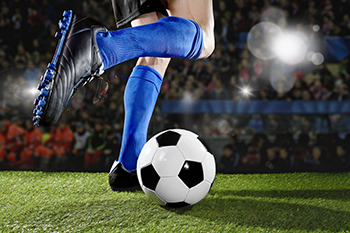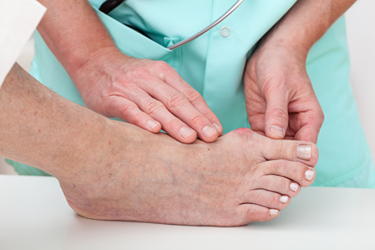Items filtered by date: April 2023
Plantar Fasciitis and Soccer
 Plantar fasciitis is an extremely common affliction of the foot. It affects the plantar fascia, which is the band of tissue that is found along the sole of the foot. Plantar fasciitis may develop when the plantar fascia becomes irritated and inflamed. This painful foot condition can be caused by many sports and strenuous physical activities, such as soccer. Since soccer requires an athlete to engage in frequent sideways and diagonal cuts while running, extra pressure is exerted on the feet. In particular, the medial heel and arch are subject to a significant amount of force in American soccer players. The risk of plantar fasciitis may be even more pronounced in substitute soccer players who, after initially warming up their bodies, wait on the sidelines for long periods of time. This may cause their muscles to tighten up before playing again and can make an individual more susceptible to plantar fasciitis. If you are a soccer player, it is suggested that you contact a podiatrist who will be able to provide you with the treatment for plantar fasciitis.
Plantar fasciitis is an extremely common affliction of the foot. It affects the plantar fascia, which is the band of tissue that is found along the sole of the foot. Plantar fasciitis may develop when the plantar fascia becomes irritated and inflamed. This painful foot condition can be caused by many sports and strenuous physical activities, such as soccer. Since soccer requires an athlete to engage in frequent sideways and diagonal cuts while running, extra pressure is exerted on the feet. In particular, the medial heel and arch are subject to a significant amount of force in American soccer players. The risk of plantar fasciitis may be even more pronounced in substitute soccer players who, after initially warming up their bodies, wait on the sidelines for long periods of time. This may cause their muscles to tighten up before playing again and can make an individual more susceptible to plantar fasciitis. If you are a soccer player, it is suggested that you contact a podiatrist who will be able to provide you with the treatment for plantar fasciitis.
Plantar fasciitis can be very painful and inconvenient. If you are experiencing heel pain or symptoms of plantar fasciitis, contact Gary Cockrell, DPM from Tennessee. Our doctor can provide the care you need to keep you pain-free and on your feet.
What Is Plantar Fasciitis?
Plantar fasciitis is the inflammation of the thick band of tissue that runs along the bottom of your foot, known as the plantar fascia, and causes mild to severe heel pain.
What Causes Plantar Fasciitis?
- Excessive running
- Non-supportive shoes
- Overpronation
- Repeated stretching and tearing of the plantar fascia
How Can It Be Treated?
- Conservative measures – anti-inflammatories, ice packs, stretching exercises, physical therapy, orthotic devices
- Shockwave therapy – sound waves are sent to the affected area to facilitate healing and are usually used for chronic cases of plantar fasciitis
- Surgery – usually only used as a last resort when all else fails. The plantar fascia can be surgically detached from the heel
While very treatable, plantar fasciitis is definitely not something that should be ignored. Especially in severe cases, speaking to your doctor right away is highly recommended to avoid complications and severe heel pain. Your podiatrist can work with you to provide the appropriate treatment options tailored to your condition.
If you have any questions please feel free to contact our offices located in Brentwood and Madison, TN . We offer the newest diagnostic and treatment technologies for all your foot and ankle needs.
What Is a Bunion?

A bunion is considered to be a deformity that can happen for genetic reasons, or from wearing shoes that are too tight. A bunion is a bony growth which forms on the side of the big toe. Severely protruding bunions may cause the other toes to shift toward each other as well, and larger shoes may need to be worn. Some people have corns and calluses that grow on top of the toes, as a result of the friction that is caused when they touch the top of the shoe. Wearing high heels may cause a bunion to form from the limited amount of room the toes have to move in. Relief may be found with mild bunions when a protective pad is worn over them. Some patients have chosen to wear custom-made orthotics, which may help the foot to feel more comfortable in the shoe. If you have a bunion, it is suggested that you consult with a podiatrist who can guide you toward the treatment option that is best for you.
If you are suffering from bunion pain, contact Gary Cockrell, DPM of Tennessee. Our doctor can provide the care you need to keep you pain-free and on your feet.
What Is a Bunion?
Bunions are painful bony bumps that usually develop on the inside of the foot at the joint of the big toe. As the deformity increases over time, it may become painful to walk and wear shoes. Women are more likely to exacerbate existing bunions since they often wear tight, narrow shoes that shift their toes together. Bunion pain can be relieved by wearing wider shoes with enough room for the toes.
Causes
- Genetics – some people inherit feet that are more prone to bunion development
- Inflammatory Conditions - rheumatoid arthritis and polio may cause bunion development
Symptoms
- Redness and inflammation
- Pain and tenderness
- Callus or corns on the bump
- Restricted motion in the big toe
In order to diagnose your bunion, your podiatrist may ask about your medical history, symptoms, and general health. Your doctor might also order an x-ray to take a closer look at your feet. Nonsurgical treatment options include orthotics, padding, icing, changes in footwear, and medication. If nonsurgical treatments don’t alleviate your bunion pain, surgery may be necessary.
If you have any questions, please feel free to contact our offices located in Brentwood and Madison, TN . We offer the newest diagnostic and treatment technologies for all your foot care needs.
Are Bunions Affecting Your Everyday Life?
Poor Circulation and Sitting With Legs Crossed

Many people, ranging from young children to senior citizens, may like to sit with their legs crossed at the knee while sitting in a chair. Individuals often sit in this position frequently, and it may come naturally. However, sitting in this position for extended periods could potentially have unwelcome health consequences to consider. For example, crossing the legs at the knees while seated can negatively impact their blood circulation. As a result, the weight of one leg on top of the other might impair proper circulation, leading to swelling at the ankles. Such reduced circulation and swelling at the ankles may be paired with leg cramps. In some cases, when an individual sits cross-legged for extended periods, they may have a numbing and tingling sensation. If you sit with your legs crossed, it is suggested that you contact a podiatrist today who can inform you of how this can negatively affect your health and help you with any problems that may arise.
Poor circulation is a serious condition and needs immediate medical attention. If you have any concerns with poor circulation in your feet contact Gary Cockrell, DPM of Tennessee. Our doctor will treat your foot and ankle needs.
Poor Circulation in the Feet
Poor blood circulation in the feet and legs is can be caused by peripheral artery disease (PAD), which is the result of a buildup of plaque in the arteries.
Plaque buildup or atherosclerosis results from excess calcium and cholesterol in the bloodstream. This can restrict the amount of blood which can flow through the arteries. Poor blood circulation in the feet and legs are sometimes caused by inflammation in the blood vessels, known as vasculitis.
Causes
Lack of oxygen and oxygen from poor blood circulation restricts muscle growth and development. It can also cause:
- Muscle pain, stiffness, or weakness
- Numbness or cramping in the legs
- Skin discoloration
- Slower nail & hair growth
- Erectile dysfunction
Those who have diabetes or smoke are at greatest risk for poor circulation, as are those who are over 50. If you have poor circulation in the feet and legs it may be caused by PAD and is important to make changes to your lifestyle in order to reduce risk of getting a heart attack or stroke. Exercise and maintaining a healthy lifestyle will dramatically improve conditions.
As always, see a podiatrist as he or she will assist in finding a regimen that suits you. A podiatrist can also prescribe you any needed medication.
If you have any questions please feel free to contact our offices located in Brentwood and Madison, TN . We offer the newest diagnostic and treatment technologies for all your foot and ankle needs.
What Is a Brannock Device?

Many foot conditions may be avoided when shoes fit correctly. Bunions, hammertoes, and ingrown toenails are uncomfortable ailments that fit this category. To determine the correct shoe size, it is beneficial to have the feet measured. This can be accomplished by using a Brannock device, which is found in the majority of shoe stores. If this is not available, the feet can be measured by tracing them on a piece of paper while standing up. Shoes should be tried on and walked in before determining the proper size. This is successful in noticing if the shoe is too small or too large, and other shoes may need to be chosen if they do not fit correctly. If you would like additional information regarding how to buy shoes that fit properly, it is suggested that you confer with a podiatrist.
It is important to find shoes that fit you properly in order to avoid a variety of different foot problems. For more information about treatment, contact Gary Cockrell, DPM from Tennessee. Our doctor will treat your foot and ankle needs.
Proper Shoe Fitting
Shoes have many different functions. They cushion our body weight, protect our feet, and allow us to safely play sports. You should always make sure that the shoes you wear fit you properly in order to avoid injuries and deformities such as: bunions, corns, calluses, hammertoes, plantar fasciitis, stress fractures, and more. It is important to note that although a certain pair of shoes might be a great fit for someone else, that doesn’t mean they will be a great fit for you. This is why you should always try on shoes before buying them to make sure they are worth the investment. Typically, shoes need to be replaced ever six months to one year of regular use.
Tips for Proper Shoe Fitting
- Select a shoe that is shaped like your foot
- Don’t buy shoes that fit too tight, expecting them to stretch to fit
- Make sure there is enough space (3/8” to ½”) for your longest toe at the end of each shoe when you are standing up
- Walk in the shoes to make sure they fit and feel right
- Don’t select shoes by the size marked inside the shoe, but by how the shoe fits your foot
The shoes you buy should always feel as good as they look. Shoes that fit properly will last longer, feel better, and improve your way of life each day.
If you have any questions, please feel free to contact our offices located in Brentwood and Madison, TN . We offer the newest diagnostic and treatment technologies for all your foot care needs.

